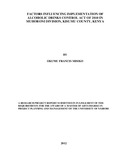| dc.description.abstract | This Project research discussed factors influencing implementation of Alcoholic Drinks
Control Act of 2010 and how the government tried to influence the implementation of the
Alcoholic Act itself. The dangers posed by society in establishing the positive and negative
aspects of alcohol in society. The knowledge and perceptions of the Alcoholic Act to the local
Administration, the Family system, the community and its integration and re settlement. Most
successful families benefitted a great deal from the sale of the Alcohol across various networks.
Some countries trying to authorise the brew reached some time and decided to lift the licence. It
remained a matter of deliberations until when new governments placed mechanism to allow the
sale. Various Acts were put in place to solve the problem. The influence of this organ made
tremendous impact on the alcoholic uptake. In many of the countries that authorised the
brewing and sale it realised quite a large portion had to cease from taking the alcohol. When
some ideology is hindered from the people‟s perception then it becomes accepted to the
subjects. This made many to take on the precinct that if found then vigorous steps, conviction in
nature, may be subjected to them. It was necessary to understand whether the governance
structures and systems were informed of the alcoholic act and eventually pinpoint the
availability of resources to enable the full implementation of the Alcoholic Act of 2010. In the
study, the researcher explored stakeholder sensitization influencing implementation of the Act
where vital areas such as the views on substance abuse, the magnitude of substance abuse,
factors influencing substance abuse population vulnerability were included. The study focused
on attitude of stakeholders upon which incorporated peer influence, parental influence ,access to
alcohol, role of alcohol in society, practices around advertising and promotion, information and
education, healthcare of healthcare providers, quality and integrity, among others. In the
structures and systems dwelt on the inflation, legislation landscape fragmentation, then
resources allocation had enforcement resources, Administrative placement, state-local
partnerships, administrative penalties and limits to authority. Questions concerning the
objectives needed to be articulated to help in solving the demise. The study used descriptive
research design due to the vast area. The study used both quantitative and qualitative data
collection systems. Random Purposive sampling was used involving local administrations, head
of departments, businessmen and some victim of alcohol. The researcher analysed data using
simple calculations and comparisons of compiled data in percentages and in representing them
in simple tables. Data using questionnaires was grouped, organized and categorised according
to specific objectives and research questions. These were answered using descriptive statistics
of frequency counts and percentages. A total of 12(37.5%) stakeholders said that their parents
by sensitizing youth between 15-35 years on the dangers of alcohol and substance abuse. A total
of 5(62.5%) local administration officials said that the local community was supportive of the
reforms the local administration staff believed that the local community was positive because,
they reported incidents of drug abuse among them. Out of the 11 stakeholders who affirmed that
protective factors were enhanced, 4(36.36%) said that it was done so by educating and
sensitizing the public on the dangers of drug abuse. The study found that though the
stakeholders were sensitized on the act, it only went as far as them knowing about the act. The
stakeholders were also having a positive attitude towards the act. However efforts to implement
the act were hampered by poor resource endowment in terms of data management systems,
personnel, enforcement resource, agencies and financial resources. This affected the
implementation of the alcohol act. The study recommended that there was need for more
sensitization among stakeholders through trainings, workshops and seminars. The act should be
implemented step by step with the participation of all stakeholders so as to have a positive
attitude. There should be merger of private and public institutions as well as non-governmental
organizations. The available resources should be optimally used. The research suggested to be
carried out at another county more so in an urban setting. Senior decision makers should be
involved. | en_US |

